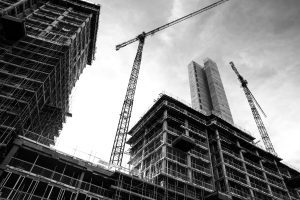
Up until now, policy intended to make buildings more efficient has focused on operational emissions. Embodied carbon within construction is not assessed or controlled, therefore it is no surprise that little or no progress has been achieved in reduction.
Engineering company Arup has calculated that around 50% of the whole-life emissions of a building could come from the carbon emitted during the construction and demolition phase[1]. To address this, the Environmental Audit Committee (EAC) has recommended that the Government introduces a mandatory requirement for whole-life carbon assessments for buildings.
In June 2022 the EAC’s report “Building to net zero: costing carbon in construction” set out clear actions and recommendations for the UK Government to meet its legally binding target to reach net zero by 2050, whilst also committing a 68% reduction in carbon emissions by 2030 through its COP26 target[2]. The report also stated that “if the UK continues to drag its feet on embodied carbon, it will not meet net zero or its carbon budgets.” A clear timeframe is required for introducing whole-life carbon assessments that include strict targets. Ideally the government should have this in place by the end of 2022 to be introduced no later than December 2023.
So why the delay?
The lack of further action is generally a complex issue in that embodied carbon is still a relatively new term to some, with both large and small developers stuck in ‘unfamiliar territory’ which can slow down progress within the industry. There is a need to further engage businesses and to start questioning and educating on the importance that embodied carbon reductions can have on the whole-life carbon of a building. A further issue to those who are actively engaging in carbon reductions is that there is no easily accessible source of whole-life cost information; especially when trying to make a quick comparison between what we know as traditional grey infrastructure such as concrete and steel and green infrastructure alternatives such as timber[3].
At SHIFT we understand these pertinent issues, as sourcing these environmental product declarations can be an arduous process and compiling accurate information is currently best done through creating a database of all current declarations to ensure that the highest possible accuracy is achieved. Everyone has a role to stimulate the growth of transparency by requesting this information before the point of purchase. This will further raise the importance of the issue within the industry and encourage the investment of research into sourcing.
If you’d like to know more about the embodied carbon of your organisation, please get in touch.
[1] https://www.arup.com/news-and-events/arup-commits-to-whole-lifecycle-carbon-assessments-for-buildings-and-withdrawal-from-fossil-fuels
[2] https://committees.parliament.uk/committee/62/environmental-audit-committee/news/171103/emissions-must-be-reduced-in-the-construction-of-buildings-if-the-uk-is-to-meet-net-zero-mps-warn/
[3] https://www.cemnet.com/News/story/172861/momentum-builds-for-embodied-carbon-regulation.html
Image by Ben Allen on Unsplash
